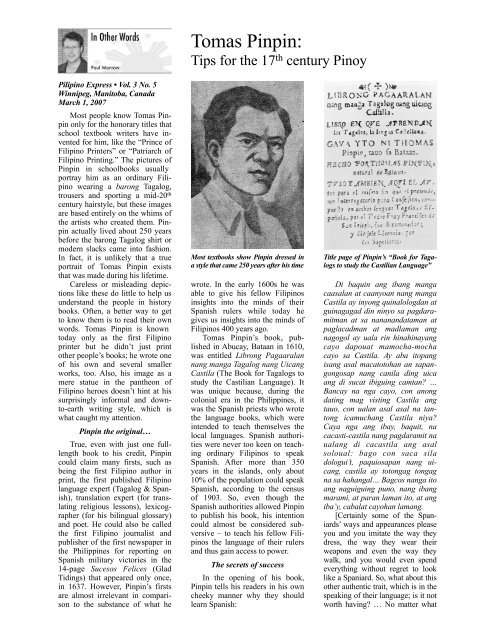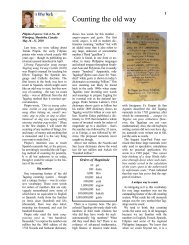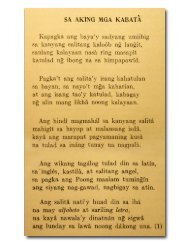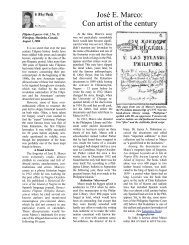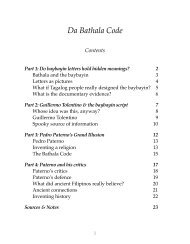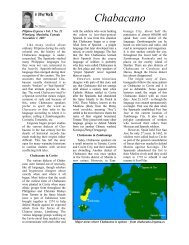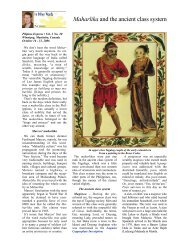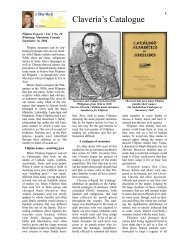070301 Tomas Pinpin.pdf - Pilipino Express
070301 Tomas Pinpin.pdf - Pilipino Express
070301 Tomas Pinpin.pdf - Pilipino Express
You also want an ePaper? Increase the reach of your titles
YUMPU automatically turns print PDFs into web optimized ePapers that Google loves.
<strong>Tomas</strong> <strong>Pinpin</strong>:<br />
Tips for the 17 th century Pinoy<br />
<strong>Pilipino</strong> <strong>Express</strong> • Vol. 3 No. 5<br />
Winnipeg, Manitoba, Canada<br />
March 1, 2007<br />
Most people know <strong>Tomas</strong> <strong>Pinpin</strong><br />
only for the honorary titles that<br />
school textbook writers have invented<br />
for him, like the “Prince of<br />
Filipino Printers” or “Patriarch of<br />
Filipino Printing.” The pictures of<br />
<strong>Pinpin</strong> in schoolbooks usually<br />
portray him as an ordinary Filipino<br />
wearing a barong Tagalog,<br />
trousers and sporting a mid-20 th<br />
century hairstyle, but these images<br />
are based entirely on the whims of<br />
the artists who created them. <strong>Pinpin</strong><br />
actually lived about 250 years<br />
before the barong Tagalog shirt or<br />
modern slacks came into fashion.<br />
In fact, it is unlikely that a true<br />
portrait of <strong>Tomas</strong> <strong>Pinpin</strong> exists<br />
that was made during his lifetime.<br />
Careless or misleading depictions<br />
like these do little to help us<br />
understand the people in history<br />
books. Often, a better way to get<br />
to know them is to read their own<br />
words. <strong>Tomas</strong> <strong>Pinpin</strong> is known<br />
today only as the first Filipino<br />
printer but he didn’t just print<br />
other people’s books; he wrote one<br />
of his own and several smaller<br />
works, too. Also, his image as a<br />
mere statue in the pantheon of<br />
Filipino heroes doesn’t hint at his<br />
surprisingly informal and downto-earth<br />
writing style, which is<br />
what caught my attention.<br />
<strong>Pinpin</strong> the original…<br />
True, even with just one fulllength<br />
book to his credit, <strong>Pinpin</strong><br />
could claim many firsts, such as<br />
being the first Filipino author in<br />
print, the first published Filipino<br />
language expert (Tagalog & Spanish),<br />
translation expert (for translating<br />
religious lessons), lexicographer<br />
(for his bilingual glossary)<br />
and poet. He could also be called<br />
the first Filipino journalist and<br />
publisher of the first newspaper in<br />
the Philippines for reporting on<br />
Spanish military victories in the<br />
14-page Sucesos Felices (Glad<br />
Tidings) that appeared only once,<br />
in 1637. However, <strong>Pinpin</strong>’s firsts<br />
are almost irrelevant in comparison<br />
to the substance of what he<br />
Most textbooks show <strong>Pinpin</strong> dressed in<br />
a style that came 250 years after his time<br />
wrote. In the early 1600s he was<br />
able to give his fellow Filipinos<br />
insights into the minds of their<br />
Spanish rulers while today he<br />
gives us insights into the minds of<br />
Filipinos 400 years ago.<br />
<strong>Tomas</strong> <strong>Pinpin</strong>’s book, published<br />
in Abucay, Bataan in 1610,<br />
was entitled Librong Pagaaralan<br />
nang manga Tagalog nang Uicang<br />
Castila (The Book for Tagalogs to<br />
study the Castilian Language). It<br />
was unique because, during the<br />
colonial era in the Philippines, it<br />
was the Spanish priests who wrote<br />
the language books, which were<br />
intended to teach themselves the<br />
local languages. Spanish authorities<br />
were never too keen on teaching<br />
ordinary Filipinos to speak<br />
Spanish. After more than 350<br />
years in the islands, only about<br />
10% of the population could speak<br />
Spanish, according to the census<br />
of 1903. So, even though the<br />
Spanish authorities allowed <strong>Pinpin</strong><br />
to publish his book, his intention<br />
could almost be considered subversive<br />
– to teach his fellow Filipinos<br />
the language of their rulers<br />
and thus gain access to power.<br />
The secrets of success<br />
In the opening of his book,<br />
<strong>Pinpin</strong> tells his readers in his own<br />
cheeky manner why they should<br />
learn Spanish:<br />
Title page of <strong>Pinpin</strong>’s “Book for Tagalogs<br />
to study the Castilian Language”<br />
Di baquin ang ibang manga<br />
caasalan at caanyoan nang manga<br />
Castila ay inyong quinalologdan at<br />
guinagagad din ninyo sa pagdaramitman<br />
at sa nananandataman at<br />
paglacadman at madlaman ang<br />
nagogol ay uala rin hinahinayang<br />
cayo dapouat mamocha-mocha<br />
cayo sa Castila. Ay aba itopang<br />
isang asal macatotohan an sapangongosap<br />
nang canila ding uica<br />
ang di sucat ibiguing camtan …<br />
Bancay na nga cayo, con anong<br />
dating mag visting Castila ang<br />
tauo, con ualan asal asal na tantong<br />
icamuchang Castila niya<br />
Caya nga ang ibay, baquit, na<br />
cacasti-castila nang pagdaramit na<br />
ualang di cacastila ang asal<br />
soloual: bago con saca sila<br />
dologui’t, paquiosapan nang uicang,<br />
castila ay totongag tongag<br />
na sa hahangal… Bagcos nanga ito<br />
ang naguiguing puno, nang ibang<br />
marami, at paran laman ito, at ang<br />
iba’y, cabalat cayohan lamang.<br />
[Certainly some of the Spaniards’<br />
ways and appearances please<br />
you and you imitate the way they<br />
dress, the way they wear their<br />
weapons and even the way they<br />
walk, and you would even spend<br />
everything without regret to look<br />
like a Spaniard. So, what about this<br />
other authentic trait, which is in the<br />
speaking of their language; is it not<br />
worth having … No matter what
Paul Morrow • In Other Words • The <strong>Pilipino</strong> <strong>Express</strong> • March 1, 2007<br />
2<br />
Spanish clothes a person wears,<br />
without having this Spanish trait,<br />
aren’t you just a corpse So why<br />
are these others who dress like<br />
Spaniards, not also Spanish in their<br />
“underwear” habits: if someone<br />
approached them and spoke to<br />
them in the Spanish language, they<br />
would just gape like fools …<br />
Above all, this [language] is the<br />
source of many other things and it<br />
is like the flesh and everything else<br />
is just a masquerade.]<br />
<strong>Pinpin</strong>’s Tagalog may be difficult<br />
for us to understand today but<br />
to put it in perspective, this is the<br />
Tagalog language as it was spoken<br />
in the Philippines when Shakespeare<br />
was still alive and writing<br />
plays in England.<br />
<strong>Pinpin</strong> delivers most of his lessons<br />
in this conversational tone,<br />
often teasing the readers gently as<br />
he shares with them the secrets of<br />
his success. He must have been<br />
quite a character to meet. I can<br />
imagine him as the know-it-all type<br />
of person who dominates the conversations<br />
at parties and constantly<br />
asks if you agree with his opinion.<br />
A portrait of the old<br />
Tagalog language<br />
The readers of <strong>Pinpin</strong>’s book<br />
were eager to learn Spanish. Many<br />
had already learned the alphabet and<br />
numerals with much enthusiasm, to<br />
the surprise of several Spanish<br />
commentators, which is why <strong>Pinpin</strong><br />
was able to publish his Tagalog<br />
book with Spanish letters and spelling.<br />
Looking back, this was just the<br />
beginning of the end for the native<br />
baybayin writing system.<br />
Although the original purpose of<br />
the book is now obsolete, it remains<br />
as a valuable record that tells us a lot<br />
about the Tagalog language 400<br />
years ago without the effects of foreign<br />
biases and misunderstandings.<br />
Along with old words and figures of<br />
speech, <strong>Pinpin</strong>’s book reveals old<br />
Tagalog pronunciations while teaching<br />
the importance of correctly pronouncing<br />
the then-new sounds and<br />
letters of the Spanish language.<br />
Before there was Spanish, Tagalog<br />
had only three vowel letters<br />
but they could be pronounced in<br />
different ways, just as English has<br />
only five vowel letters but many<br />
more vowel sounds. The sounds of<br />
I and E were interchangeable<br />
(lalaki/lalake for man) as were U<br />
and O (tao/tau for person). <strong>Pinpin</strong><br />
stressed the importance of pronouncing<br />
Spanish letters correctly<br />
to avoid confusing the meanings<br />
of words. This included making<br />
clear and consistent distinctions<br />
between the vowel sounds. Among<br />
his many firsts, <strong>Pinpin</strong> was probably<br />
one of the first writers to<br />
comment on the age-old problem<br />
that some Filipinos have when<br />
they mix up their Ps and Fs.<br />
Monument in Plaza San Lorenzo,<br />
Binondo Manila<br />
Fr. Blancas de San Jose published the<br />
first ever Tagalog grammar in 1610.<br />
<strong>Pinpin</strong> printed it in the priest’s own shop.<br />
Along with linguistic and cultural<br />
insights, <strong>Pinpin</strong> also preserved for us<br />
the old Tagalog counting system,<br />
though his intention at the time was<br />
to teach Filipinos the Spanish numbers.<br />
We still use most of the Tagalog<br />
words for the numbers today but the<br />
system of counting in <strong>Pinpin</strong>’s day<br />
was very different. The number 21,<br />
for example, was not said dalawampu’t<br />
isa or “two tens and one,” as<br />
we’d expect. It was said, maikatlong<br />
isa or, as some grammarians have<br />
explained this to mean, “having one<br />
for the third set of ten.”<br />
<strong>Pinpin</strong>’s life<br />
Not much is known for certain<br />
about <strong>Tomas</strong> <strong>Pinpin</strong>’s personal life.<br />
Some modern sources say he was<br />
Chinese but the cover of his book<br />
states that he is a native of Bataan,<br />
and <strong>Pinpin</strong> himself says in the introduction<br />
that he is a Tagalog. He was<br />
born in the barrio Mabatang, Abucay<br />
in Bataan, sometime between 1580<br />
and 1585. The parish records of<br />
Abucay were lost when Dutch raiders<br />
attacked the town in 1646.<br />
<strong>Pinpin</strong> learned his craft in about<br />
1608 or 1609 from Christian Chinese<br />
printers such as Juan and Pedro de<br />
Vera, and Luis Beltran who had already<br />
printed several books for Spanish<br />
missionaries. In 1610, <strong>Pinpin</strong> was<br />
working on the printing press of Father<br />
Blancas de San Jose in Abucay,<br />
Bataan. He is also known to have<br />
worked on printing projects in Pila,<br />
Laguna (1613) and Binondo, Manila<br />
(1623-27). <strong>Pinpin</strong>’s own book, Librong<br />
Pagaaralan, was printed by<br />
Diego Talaghay, thought to be his<br />
assistant as he may have been managing<br />
Father Blancas’ shop by that time.<br />
<strong>Pinpin</strong> printed at least 14 books<br />
in his career – 15 if we count his own<br />
Libro. Other books include the first<br />
ever Tagalog grammar by Fr. Blancas<br />
de San Jose in 1610 and the first<br />
Tagalog dictionary by Fr. Pedro de<br />
San Buenaventura in 1613. His son,<br />
Simon <strong>Pinpin</strong> took over the business<br />
in about 1640, possibly after <strong>Tomas</strong><br />
passed away, because there are no<br />
records of him after that date.<br />
E-mail the author at<br />
feedback@pilipino-express.com<br />
Comments are also welcome on<br />
Paul Morrow’s FaceBook page<br />
Visit www.mts.net/~pmorrow for<br />
more Filipino history & language.


